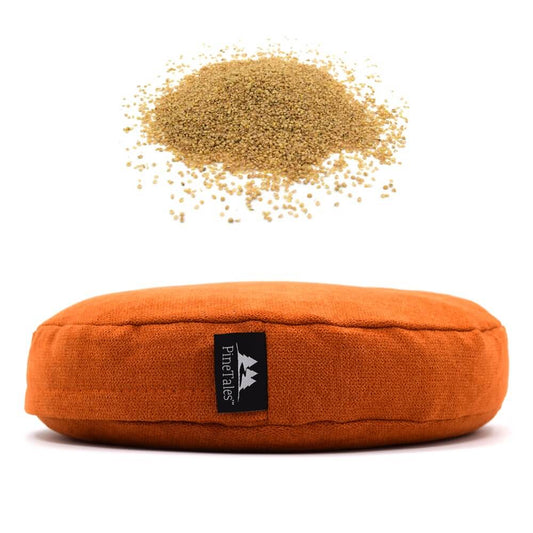You finally got your Fitbit (or any other sleep tracker) and are super excited to track your sleep for the first time. You crawl into bed, lay down on your stomach sleeper pillow, and turn on sleep mode. Roughly 8 hours later, you wake up and look at your phone to check your sleep analysis.
You see colorful line graphs, bar graphs, percentages, and a rating scale outlining how many minutes of REM, light, and deep sleep you got. You may even find information on restorative sleep, your sleeping heart rate, and how much “restful sleep” you got. It looks informative – but what does it all mean?
It’s often A LOT more information than you anticipated. This can be confusing and difficult to interpret if you don’t understand sleep cycles and the different sleep stages. In a previous blog post, we shared some of the best sleep tracking apps on the market that provide a thorough sleep analysis (check out our blog post, A Good Night’s Sleep There’s An App for That, to read more).
At first glance, the analysis looks like something straight from a sleep lab – and in many ways, it is. Fortunately, you don’t have to be a sleep expert to understand the data. With the background information I’ll share here, you’ll be able to interpret your sleep tracker results with ease.
Sleep Cycle
Our sleep is quite complex. A lot is going on, and each night, we often go through several rounds of our sleep cycle. According to the Sleep Foundation, most people will go through four to six sleep cycles a night which last roughly 90 minutes each. Each cycle changes, with the first cycle being the longest. So although it may seem like nothing is happening as you sleep on your sobakawa buckwheat hulls pillow, your brain and body have been hard at work! Within each sleep cycle, you will experience four distinct sleep stages.
Sleep Stages
Each sleep tracker works a bit differently. Wearable sleep trackers measure the quality of your sleep using accelerometers or small movements, as well as your heart rate. The app trackers without additional sensors often use sound analysis to track your sleep. By tapping into these analyses, the tracker can estimate how much time you have spent in various sleep stages. Each of these sleep stages serves a different purpose and can shed light on any sleep-related issues you may be experiencing.
Sleep experts use four stages to describe sleep. This was updated by the American Academy of Sleep in 2007. Before this, sleep was defined in 5 stages. To simplify things, these stages are often defined with user-friendly terms like light and deep sleep.
Light Sleep
Many popular sleep apps and tracking devices don’t specify between Stage 1 and Stage 2. Instead, they are lumped together as light seep. Here is what happens during this stage of sleep:
Stage 1 – NREM (non-Rapid Eye Movement)
This stage of your sleep cycle generally lasts 1 to 5 minutes. It’s the shortest period where you start to fall asleep on your millet hulls pillow but aren’t fully asleep yet. You know when you doze off and suddenly twitch? That happens in this stage. It’s when your brain activity is slowing, but your body hasn’t fully relaxed yet. Just like with a big twitch, it’s easy to wake in this stage. Very light sleepers find it challenging to move into the following stages because they are often being interrupted awake before moving into Stage 2.
Stage 2 - NREM (non-Rapid Eye Movement)
You are falling into a deeper sleep in this stage but can still be easily awoken. Stage 2 lasts 10 to 60 minutes. With each cycle, this stage gets longer. Your body’s temperature has dropped, muscles are relaxed, and your heart rate and breathing have slowed. Brain activity is slow, and eye movement stops, yet there are still short bursts of brain wave activity that help prevent you from being interrupted awake. Essentially, it shuts out the outside world. Don’t let the term “light” sleep fool you. This is an integral part of your sleep cycle and takes up more than half your night’s sleep. Your brain processes memories and emotions, and your metabolism regulates itself.
Deep Sleep
When you see your “deep” sleep levels, it refers to Stage. 3.
Stage 3 - NREM (non-Rapid Eye Movement)
Have you ever tried to wake someone up, and even though you were shaking them and speaking loudly, they just wouldn’t wake? They were in Stage 3. The body is much more relaxed, and your muscle tone, pulse, and breathing rate have decreased. This stage is all about the body as it is rebuilding and repairing. During this stage, your body will secrete growth hormone to assist with cellular repair and rebuilding. Research has shown that good deep sleep levels will also help boost your immune system. Your brain activity exhibits a pattern known as delta waves, but you are not dreaming. This sleep stage generally lasts for 20 to 40 minutes.
REM
Despite being one of the most popular sleep stages, we don’t spend too much time here. Yet, it is vital for our brain health.
Stage 4 – REM (rapid eye movement)
Your brain is busy during REM. Brain activity is almost at the same level as when you are awake. This stage is all about the mind and is essential for cognitive repair and functioning.
During REM, you will experience your most vivid dreams. While your brain is busy dreaming and repairing, your body is in paralysis. This is called atonia, and your muscles experience temporary paralysis except for your eyes and those required for breathing. As the fourth stage, you typically don’t reach the REM stage until you have been asleep for about 90 minutes. During your first sleep cycle, the REM stage is much shorter, only lasting a few minutes, and as the night goes on will get longer.
Restoration
Restorative sleep is another scale used by many trackers. It is not a formal sleep stage but uses your resting heart rate to determine how peaceful or restless you were during the night. Your most restorative sleep is acquired during deep or Stage 3 sleep. Generally, your heart rate should be below your daytime resting heart rate, and if you are agitated or tossing and turning throughout the night, it can adversely affect your quality of sleep.
How much sleep do I need in each sleep stage?
This is the big question. You may see you had 35minues of REM sleep last night, but no way of knowing if this is good or bad. There are some variables here and the answer depends on factors such as age, alcohol use, sleep disorders, and long-term sleep patterns. Here are some guidelines to help you understand your sleep cycle.
Generally, you should see that most of the night was spent in the light sleep stage (Stage 1 and 2). On average, people spend between 50 to 60% of their sleep in this stage. According to sleep experts, you can’t get too much deep sleep as your body will determine how much is needed. Once you hit that natural quota, you will spend the remaining time in REM or light sleep.
As you comfortably lay on your stomach sleeper pillow - so much is going on! It’s like an entire manufacturing plant is underworks repairing and refreshing your mind and body. When you don’t get enough deep sleep, this biological factory can’t effectively finish the repairs, which results in you feeling sleepy and unrefreshed in the morning. Even with the most comfortable millet hulls pillow, there are factors such as age that can interfere with the amount of deep sleep you get.
You should see about 20 to 25% REM sleep on your sleep tracker, occurring primarily in the latter half of the night. Like a lack of deep sleep, a lack of REM will make you feel groggy in the AM. It can also lead to memory and focus difficulties. Some medications, like antidepressants, can cut your REM sleep stage in half, which makes you feel mentally foggy and lethargic. Unlike deep sleep, you can get too much REM. This is why sleeping too long can have adverse effects like increased irritability, anxiety, and a reduced mood. As mentioned previously, once you have hit your deep sleep requirements, your body will designate your sleep to light or REM, but once you exceed 25% REM, it can cause moodiness.
Many of the sleep apps and trackers say they will optimize your wake-up time to leave you feeling more refreshed. These trackers can do so by analyzing your sleep cycles and stages. So as you catch Z’s on your sobakawa buckwheat hulls pillow, your tracker will start to wake you at the optimal time, which is your lightest stage of sleep. More advanced trackers will continuously track and collect your data and adjust accordingly to provide you with a more accurate analysis and wake-up call.
The secret to using Fitbit, an Apple watch, or any other sleep tracker app is to not obsess over it. It can be helpful to know why you aren’t feeling refreshed in the morning or compare the effectiveness of new bedtime habits, but once you are asleep, you can’t control the amount of light, deep, or REM you get. For a good night's sleep, your best bet is to practice proper sleep hygiene, be consistent and get yourself a comfortable, supportive pillow like a sobakawa buckwheat hulls pillow, millet hulls pillow, or stomach sleeper pillow.





